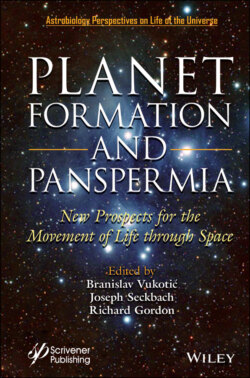Читать книгу Planet Formation and Panspermia - Группа авторов - Страница 35
4.3 Conclusions
ОглавлениеIncorporating the panspermia hypothesis might significantly improve the existing models by expanding them to include phenomena from the stellar level to the cosmological. As we have estimated, life need only occurs in 1 out of 2,000 galaxies to meet any assumption that life occurs throughout the universe [4.16]. The foundation of panspermia, a form of matter exchange, has a potential to improve habitability models by making them connect the habitability relevant phenomena from the stellar level to the cosmological scales of galactic clusters.
From all habitability aspects that appear to be relevant for the panspermia hypothesis, the most interesting appears to be the consequence of stellar flybys. Although the flybys can disrupt the habitability of the planets in the system, they can, in turn, fill the galaxy with scattered rogue planets and small bodies, possibly carrying living organisms.
At present, there is much evidence of organic matter almost everywhere in the universe [4.30]. The thousands of exoplanets that we have discovered so far should thus not suffer from the lack of building blocks for life. Small bodies of those systems are likely to supply such material in pristine form to respective planetary hosts. The possible evidence for abiogenesis is discussed in [4.18], such as the prevailing homochirality of dust and other interstellar matter, from which the planets are formed. Whether life first appears in the molecular gas clouds and dust or within the fully formed planetary systems is yet to be ascertained. Regardless, the latter scenario also has a panspermia potential to spread life, especially within the crowded regions of the galaxy where flybys of stellar systems are common. This might offer a goldilocks solution. While in crowded areas of a galaxy, there is much possibility for launching life carriers out into galactic space, there is less chance for life to develop in often disturbed planetary systems. Panspermia seems likely between stars in the same stellar cluster while “open” interstellar space seems to offer less prospects. On the other hand, the less crowded environments are more habitable in terms of less potential for disruption of planetary orbits and have less background radiation than stellar clusters.
If the Solar system migrated from the inner parts of the galactic disk, then it might have gathered a collection of organic/life material in addition to the budget available at its time of birth. While floating to areas less populated with stars, this material could encounter better conditions to form a biosphere on one of the Solar system planets.
It is evident that matter undergoes significant mixing, within stellar systems, galaxies, and also between galaxies. If this proves irrelevant for the appearance of life, then it should be significant and influence the evolution of life over cosmic timescales. Most of the matter in the universe mixes with its environment and could not be considered isolated for long periods of time. As suggested by one of the most prominent panspermia proponents [4.33], life should be viewed rather as a cosmic phenomenon and not a phenomenon related to Earth. Organic and possibly living material should be available across galactic space. The panspermia hypothesis appears to have no contradictions with our current knowledge and it offers a bunch of clear predictions for future empirical testing, in accordance with the best traditions of modern epistemology and the scientific method. The question that arises then is not whether life can spread/appear at some point in the galaxy but when. Future models of habitability should take this into consideration in order to be more versatile and realistic.
